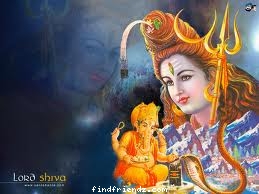
miltonrai1[2] |
Among all the inter-relations between Gods in the Hindu mythology, perhaps one of the most interesting and often controversial one is the Shiva-Vishnu relationship. Both happen to be part of the Hindu Trimurty or Trinity along with Lord Brahma. Even though all three of them are supposed to be equal in all respects, cult worshippers and communities have emerged that worship Shiva (Shaivites) and Vishnu (Vaishnavs) individually, consider their choice of God to be the Supreme Being. Western philosophers have observed and opined that the Christian Trinity and the Hindu Trimurti are not on the same plane because under Christianity, Father, Son and the Holy Spirit are indistinguishable beyond a point. They fuse to form a singular mythography. In the Hindu Trimurti however each God has his own lore traceable to puranas dedicated to them. As such, the question of which among the three is the greatest often get raised among those that are yet to become god-realised.
The Shiva-Vishnu relationship may be charted very interestingly through almost all major Hindu religious texts. Most important however is their apparent opposing position they are assigned by the cosmic order- Shiva is the designated Destroyer and Vishnu the Preserver. It is significant therefore that their relationship must be scrutinised carefully before arriving at any conclusion. Hindu mythological philosophy is highly complex; close and cross referenced readings of scriptures actually show that All three of the Trimurti are actually extensions of each other, fulfilling the tasks of creation, preservation and destruction necessary for the continuation of life and time.
One of the most significant episodes that brought the Shiva-Vishnu relationship to a near clash of superpowers occurred when Shiva’s first wife Sati immolated herself, having to face extreme insult from her father Daksha. Daksha was a human born son of Lord Brahma, a highly learned and powerful being, he was called a Prajapati (or Lord of his praja/people). Daksha wanted his daughter to marry high, in keeping with his status and wealth, Sati however chose Shiva for her husband at her Swayamvara (ceremony where the bride got to choose from all present and eligible suitors). Daksha retaliated by arranging a yajna and deliberately ignored the obligation of inviting Shiva and Sati. This was the height of insult, but Shiva would have ignored it had it not been for the mistreatment and subsequent death of Sati. Daksha was promised protection from all the Rishis (sages) and Devas (Gods) including Lord Vishnu. Shrouded by divine protection, Daksha believed himself invincible. When Shiva’s grief over Sati’s death gave way to his rage, he sent forth Veerbhadra and Bhadrakali , two of his fiercest Bhairav (dark energy) forms against Daksha and all his defenders. The entire ensemble of divine warriors fell against Shiva’s minions. It fell ultimately upon Lord Vishnu to stop them. Vishnu tried but when stopped short of using his primary weapon against Shiva. The clash of their primary weapons would spell absolute doom for all of creation. Vishnu let Shiva have his righteous vengeance in the interest of the preservation of the universe. This was the one scenario that may be comparable to the cold war that affected our planet, reaching its height during the Cuban Missile Crisis. The fine difference lay in the fact that an all out thermo-nuclear war on Earth would cause mutually assured destruction of our planet but a Shiva-Vishnu full frontal face-off would obliterate all of creation.
The best understanding of the depth of the Shiva-Vishnu relationship may be made when we look at the various instances during which they complimented each other instead of having been in conflict. Shiva is known for his simplicity and naivety. He is called ‘Bholenath’ because of his child like earnestness. Once Shiva was pleased by a demon who asked for the boon of being able to destroy anybody he so desired, by placing his hand over their head. This demon, Bhasmasura wanted to test his power and tried to place his hand over Shiva. Shiva had no option but to flee. It was Vishnu who came to his aid. Known variously as Kapti, Challiya (both meaning deceitful) by the demons, Vishnu transformed into an absolutely beautiful woman, named Mohini. Bhasmasura was smitten. Mohini got him to dance with her and in imitation of a dance step, she got Bhasmasura to hold his hand over in his own head, successfully neutralizing the demon for good.
Even during the Samudra Manthan (churning of the cosmic ocean) to yield the nectar of immortality- Amrit, it took the joint effort of Shiva and Vishnu to deal with the associated problems. The churning brought to the fore a poison (halaahal) that could destroy all of creation. Shiva consumed the poison, and it turned his throat blue. This job of preserving the world would ideally be served by Vishnu but Shiva performed it. Later, when the distribution of Amrit was to occur, it was Vishnu who ensured that the demons would not get the gift of immortality, given their incorrigible propensity to violence. Vishnu took on his Mohini avatar and distracted the demons, serving them Sura a divine intoxicant instead of the Amrit, serving that only to the Devas. The demon general Rahu got wind of this deceit and disguised himself as a God and sat in the queue with the Devas. While serving him the Amrit Vishnu realised something amiss and immediate summoned his primary weapon- the Sudarshan Chakra and promptly beheaded Rahu. This quick transformation from the luscious emblem of lust into an ever ready warrior shows the destructive side of Lord Vishnu, a role that fit best Lord Shiva.
There is a third and most controversial aspect to the Shiva-Vishnu relationship. This one brings the two super powers of Hindu mythology into a kind of fundamental conflict that broaches the concept of sexuality most explicitly. The Brahmanda Purana tells us of the time when Shiva was smitten by the utter beauty of Vishnu in his Mohini form. It is said, Shiva pursued Mohini with an abandon to the utter embarrassment of his wife Goddess Parvati. Even though homosexuality is not explicitly mentioned, copulation between the two definitely happens to be among the lesser talked of secret in Hindu myth. The objective is to highlight that even Shiva’s powerful asceticism is not beyond Vishnu’s power of persuasion. The birth of the God Aiyanar, referred alternately as Kartikeya is said to be the product of the copulation between Shiva and Vishnu. Considering the fact that there was no woman present in the process of his birth, Aiyanar is supposed to be the perfect mixture of Shiva’s destructive power and Vishnu’s power of preservation. He was designated the General of the army of the Gods and is credited with the destruction of the demon Tarakasura, even when he was just a child.
Ancient statues and paintings show the two gods fused in the same body as Harihara and there is the Sree Sankar Narayana temple in the Palakkad district of the Indian state of Tamil Nadu where the two deities are worshipped together in a single body.
The overarching ideas that emerge from the observation of all point of correlation between the myths of Shiva-Vishnu relationship reveals a simple truth that has clear secular implications. The forces of preservation and destruction must work in tandem with each other if life and existence is to run smoothly. Regardless of which religion we practice or which God we bow to, almost all religions profess that divinity is omnipresent and dwells within each of us. Away from a religious domain, critical thought reveals that each of us have the potential power of preservation and destruction within us. Without destruction, new creation is not possible and the resultant stasis leads to decay- the antithesis of preservation. The progression of time cycles and life cycles cannot occur without the conjoined effort the Shiva-Vishnu relationship stands for.
Posted on: 16 Jul 2013 11:50 am |

